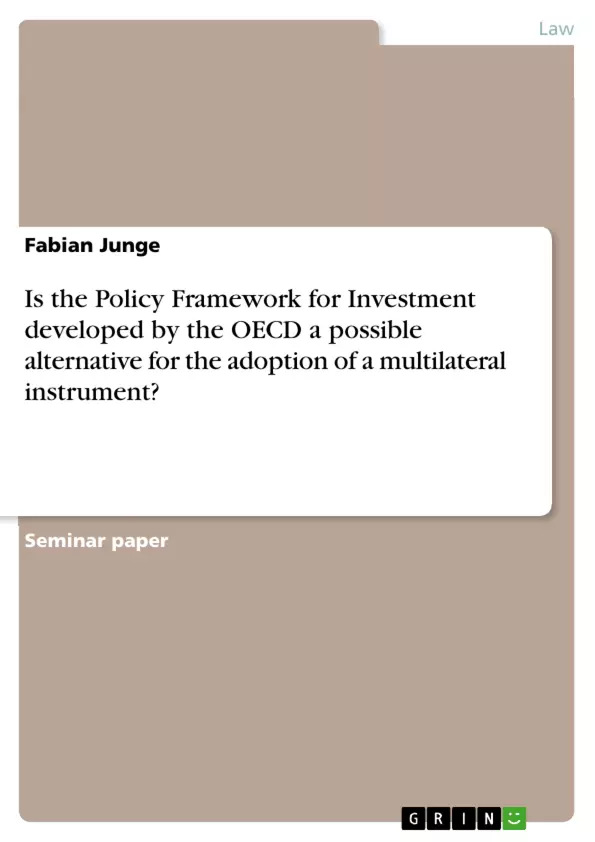When examining the development of foreign direct investment and the effects of multinational
corporations over the last decades, one has to come to the conclusion that the importance increased and
grew significantly. Until the 1970s most of the countries were opposed to foreign direct investment due to
a fear of losing economic and political independence by allowing foreign control over their economic
resources and their key industries. Since the 1990s, there has been a positive turn towards foreign direct
investment and its liberalization, because it is predominantly seen as requirement for economic growth,
productivity increase, creation of export potential and technology transfer. As a result, the amount of
foreign direct investment expanded faster than the world economy and the volume of international trade
resulting in a need to control the investment flows and to regulate the area.1
By virtue of the rather sensitive topic of foreign direct investments, it was impossible in the past for the
international community to agree upon an uniform and harmonized international regime setting out the
standards for international investments. Hence, a multitude of national and international policy rules and
principles govern the relevant aspects in this field resulting in a variety of international investment
agreements. As an example, more than 2670 bilateral investment treaties and more than 270 other
international investment agreements have been adopted globally until the end of 2008.2
Nevertheless, the plurality of the different international investment agreements with their different scopes,
different types, different signatories have led to a patchwork of treaties resulting in a highly fragmented
and incoherent international investment regime. As a result of this and the problems accompanying it,
such as a more and more complex structure and an increase in investment disputes due to the
interpretation and implementation of these treaties, the desire to adopt a general coherent framework for
investment has been stirred, especially by international organizations like the WTO or the OECD.
The OECD (Organization for Economic Co-operation and Development) is an international economic
organization consisting out of 34 countries and was founded in 1961 to stimulate economic progress and
world trade.
Inhaltsverzeichnis (Table of Contents)
- A. Introduction
- B. Multilateral Agreement on Investment
- I. Advantages
- II. Reasons for Failure
- 1. Controversies
- 2. Criticism
- a. Developing countries
- b. NGOs
- C. Policy Framework for Investment
- I. Advantages
- II. Disadvantages
- D. Conclusion
Zielsetzung und Themenschwerpunkte (Objectives and Key Themes)
This term paper aims to analyze the Policy Framework for Investment (PFI) developed by the OECD and assess its potential as an alternative to a multilateral investment agreement (MAI). It explores the advantages and disadvantages of both approaches, taking into account the historical context of international investment law and the challenges posed by the globalization of foreign direct investment.
- The historical development of international investment law and the challenges of a fragmented regime
- The role of international organizations like the OECD and WTO in shaping international investment rules
- The strengths and weaknesses of the MAI as a multilateral framework for investment
- The advantages and disadvantages of the OECD's PFI as a potential alternative to a multilateral agreement
- The implications of these approaches for developing countries and the role of non-governmental organizations (NGOs) in the debate
Zusammenfassung der Kapitel (Chapter Summaries)
- A. Introduction: This chapter provides an overview of the evolution of foreign direct investment (FDI) and its growing significance in the global economy. It highlights the shift towards liberalization of FDI, emphasizing its importance for economic growth, productivity, and technology transfer. The chapter further discusses the historical challenges of establishing a coherent international investment regime and the complexities arising from the multitude of bilateral and multilateral agreements.
- B. Multilateral Agreement on Investment (MAI): This chapter examines the proposed MAI and its intended role in establishing a global framework for investment. It analyzes the advantages of a multilateral agreement, including potential for greater coherence and harmonization of international investment rules. Additionally, it delves into the reasons for the MAI's failure, focusing on controversies surrounding the agreement and criticism from developing countries and NGOs.
- C. Policy Framework for Investment (PFI): This chapter explores the OECD's PFI as a potential alternative to the MAI. It discusses the advantages of the PFI, such as its flexible and non-binding nature, and its focus on promoting good governance and sustainable development. The chapter also addresses potential disadvantages of the PFI, including its limited scope and the possibility of divergent interpretations across different countries.
Schlüsselwörter (Keywords)
The key terms and concepts central to this term paper are: foreign direct investment (FDI), multilateral agreement on investment (MAI), Policy Framework for Investment (PFI), OECD, WTO, developing countries, non-governmental organizations (NGOs), international investment law, globalization, economic growth, and sustainable development.
- Quote paper
- Fabian Junge (Author), 2012, Is the Policy Framework for Investment developed by the OECD a possible alternative for the adoption of a multilateral instrument? , Munich, GRIN Verlag, https://www.grin.com/document/196515



